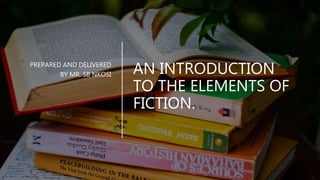An introduction to the elements of fiction
- 1. AN INTRODUCTION TO THE ELEMENTS OF FICTION. PREPARED AND DELIVERED BY MR. SB NKOSI
- 2. WHAT IS FICTION? THIS IS ALL WORKS OF LITERATURE WHICH ARE BASED ON IMAGNED REALITIES, THEY ARE NOT NECESSARILY TRUE, BUT THEY PROVIDE A MEDIUM WITHIN WHICH WE CAN VIEW LIFE. FICTION INVOLVES WRITINGS BASED ON IMAGERY SUCH AS NOVELS AND SHORT STORIES.
- 3. WHY IS IT IMPORTANT TO KNOW THE ELEMENTS OF FICTION? ? Literature is about inventing ourselves in the views of others. As readers of a text, we need to understand that these elements work together to enhance our understanding of a fictional work; each element of fiction represents a different meaning/explanation.
- 4. WHAT IS A PLOT IN A LITERARY TEXT. ? Plot refers to the sequence of events in the story ? It questions what happens in the story. ? It tells us why certain events occur in the story. In other words, it tells us the causality of actions. ? It answers questions such as: the conflicts and problems in the story
- 5. PLOT CONT¡(PLOT COMPONENTS) EXPOSITION: The start of the story, the situation before the action RISING ACTION: the series of conflicts and crisis in the story that lead to climax CLIMAX: the turning point, the most intense moment- either mentally or in action FALLING ACTION: all of the action which follows the climax RESOULUTION: the conclusion, the trying together of all the threads.
- 6. WHAT IS CHARACTERIZATION?. Characters can be people or animals in the story who perform actions and share thoughts. The important thing to examine when dealing with characterization its the development of each character. In other words, how do they progress from time to time in the plot. Characters are important because they are a medium through which a reader interacts with the story. TYPES OF CHARACTERS Flat character- less is known of this character they appear once or twice Round character- This character appears frequently in the story, in most cases the story is centered around them. Dynamic character- This is able to change throughout the story; he is not reliable. Static Character- This is a character who remains static throughout the story.
- 7. WHAT IS NARRATOR/NARRATIVE POINT OF VIEW? ? THE VOICE OF THE STORY. ? THE NARRATOR CAN BE THE MAIN CHARACTER/PROTAGONIST WHO TELLS US THE EVENTS AS THEY UNFOLD IN THE STORY. ? IN OTHER WORDS, THIS IS A WAY TO CONVEY MEANING TO THE READER. ? IT IS THE ¡®VANTAGE POINT¡¯ FROM WHICH THE NARRATIVE IS PASSED FROM AUTHOR TO READER. ? THEY ARE THREE TYPES OF NARRATIVE POINT OF VIEWS FIRST PERSON SUCH AS; I AND ME SECOND PERSON SUCH AS; YOU THIRD PERSON SUCH AS: THEY AND IT
- 8. WHAT IS A SETTING? THE TIME, PLACE, PHYSICAL DETAILS, CURCUMTANCES IN WHICH A SITUATION OCCURS SETTING INCLUDES THE BACK- GROUND, ATMOSPHERE OR ENVIRONMENT IN WHICH CHARACTERS LIVE AND MO- VE.
- 9. WHAT IS A THEME? ? This is a common thread or repeated idea that is incorporated throughout a literary text. ? A theme is a thought or idea the author presents to the reader that may be deep, difficult to understand or even to moralistic ? A theme helps the reader to understand what the story is about.
- 10. REFERENCES Moreau, D. (2015). Overview of the elements of fiction. Available from ºÝºÝߣshare at: /DonnaMoreau/donnas-elements-of-fiction?qid=78f8ad5f-9549-47e0-a209- 03fe54ccd417&v=&b=&from_search=8 (Accessed 17 August 2020) Mellati, M. (2017). The elements of fiction. Available from ºÝºÝߣshare at: /MortezaMellati/m- mellati-the-elements-of-fiction?qid=e096d96d-4fd5-46dc-ad8b-25326bdc5d2d&v=&b=&from_search=5 (Accessed 17 August 2020) Montenverde, D. (2017) Elements of Fiction. Available from ºÝºÝߣshare at: /DAPHNIEMONTEVERDE1/elements-of-fiction-71409453?qid=1d6d90e9-b3e6-4956-a9e5- 9cff54b5d5c9&v=&b=&from_search=2 (Accessed 17 August 2020) Lalacanteach (2019). Presentation for grade 9 students on Elements of Fiction. Available from ºÝºÝߣshare at: /lalacanteach/elements-of-fiction-5392687?qid=47d57c8a-ea5b-4590-b3a8- a677102e97de&v=&b=&from_search=1 (Accessed 17 August 2020) Taichung, (2015). Elements of Fiction. Available from ºÝºÝߣshare at: /taichung/elements- offiction-49100512?qid=1d6d90e9-b3e6-4956-a9e5-9cff54b5d5c9&v=&b=&from_search=6 (Accessed 17 August 2020)
- 11. THE END











